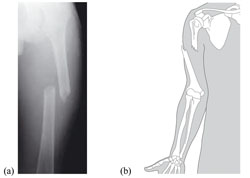Types of fractures
Fractures can be classified according to the following criteria:
- Closed or open fractures, depending on the presence or absence of skin perforation. In an open fracture, part of the broken bone pushes out through the person's muscles and skin at the site of the fracture; in a closed fracture, the broken end of the bone is not exposed to view.
- Simple or complicated fractures, depending on presence (complicated) or absence (simple) of damage to soft tissues (nerves, arteries, muscles) around the site of the fracture.
Are the fractures in the figure below simple or complicated, open or closed?

(a) X-ray picture showing a fracture of the thigh bone (femur); (b) Diagram of a fracture of the upper arm bone (humerus). (Photo (a) Courtesy of Philip Parkinson, Leeds Teaching Hospital, NHS Trust, UK; (b) The Open University, Trauma, Recovery and Repair, SDK125, Case Study 6, Figure 4.11)
Show answer
Both fractures are complicated by the displacement of the bone into the soft tissue in the thigh or upper arm. In (a) the broken ends of the bone remain inside the soft tissue, so it is a closed fracture. In (b) the broken end of the bone has penetrated right through the soft tissue and is visible outside the surface of the arm – this is an open fracture.
Last modified: Friday, 4 July 2014, 12:22 PM